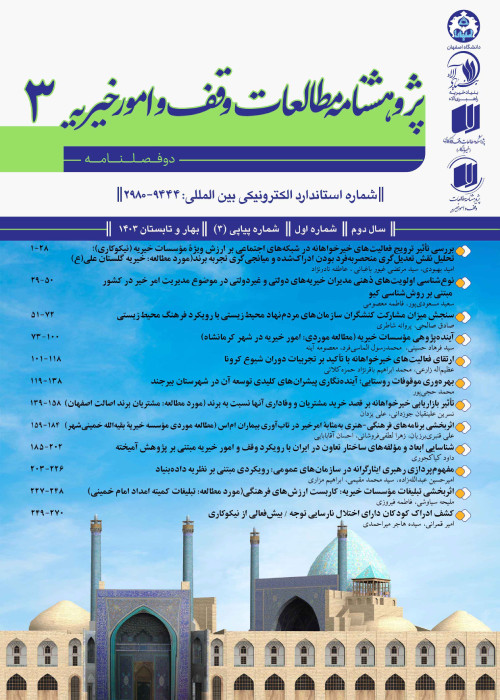Explaining the Challenges of Charitable Hospitals in Fars Province and the Solutions to Address them: A Qualitative Study
IntroductionIn the health system as a public sector, the role of charities and benefactors is important according to the characteristics and types of health services (Vaezi & Alborzi, 2017). According to current regulations, 40% of the construction costs of health centers in Iran are borne by donors and 60% by the government (Javadi Qala, 2016). In Iranian charitable hospitals, the tariffs for medical services are almost between the public and private sector tariffs. For this reason, for people who have not received services from the public sector due to the long waiting line and from the private sector due to high costs, charity hospitals are one of their best options at a more reasonable cost. Such hospitals should therefore be pioneers in providing care to groups that may be of lower socio-economic status. Hayden's (2005) study shows that nonprofit hospitals in Massachusetts, like most similar hospitals in the United States, face serious financial challenges (Hayden, 2005). Moreover, a study in Iran has shown that charitable hospitals in Tehran province face serious financial and management problems (Nekoeimokadam et al., 2020). However, the searches show that few studies have been done on the challenges of these centers and the solutions to address them in Iran. Therefore, considering the critical role of these centers in the provision of health care and also given the lack of in-depth studies in Fars province, this qualitative study is conducted with the aim of explaining the challenges faced by charitable hospitals in the province and proposing appropriate solutions. Research MethodologyThis qualitative study was conducted using the framework analysis method. The research population included senior and middle managers of three charitable hospitals in Fars province, as well as staff managers of Shiraz University of Medical Sciences (SUMS). The purposeful sampling method was used to select the participants and, at the same time, the snowball method was also used to facilitate access to the desired people. The data collection process continued until theoretical data saturation was achieved. In this regard, 12 managers of charitable hospitals and 4 managers of SUMS were interviewed. The data collection tool in this study was an in-depth semi-structured interview. Each interview began with a general question: "What challenges does the charity hospital face?", and then probing questions were asked to obtain further clarification. Immediately after each interview, the content of the conversations was transcribed verbatim and analyzed using the framework analysis method. To analyze the data, the researchers followed a 7-step method (Gale et al., 2013), including 1) Transcribing conversations, 2) Familiarization with the interview, 3) Coding, 4) Developing a working analytical framework, 5) Applying the analytical framework, 6) Charting data in the framework matrix, and 7) Data interpretation. To ensure the rigor and trustworthiness of the results, we used the four criteria proposed by Guba and Lincoln (1994), including credibility, confirmability, dependability, and transferability (Armstrong et al., 1997). Atlas T9 software was used for data analysis. The findings of the thematic analysis are presented in the form of a conceptual map. Research FindingsThe framework analysis led to the identification of three main themes, eight sub-themes, and 23 categories regarding the challenges of charitable hospitals. The main themes are "management process challenges", "economic and financial system problems", and "resource constraints".1- Management process challengesThis theme explains the inefficient management system, the multiple external supervision, and the ambiguity of the decision-making system.2- Economic and financial system problemsThe second theme explains important problems such as the instability of financial resources and investments, the inefficient use of existing resources, and the unfavorable tariff system of charitable hospitals.3- Resource constraintsThis theme refers to issues related to the provision of physical space, capital equipment, and human resources required by charitable hospitals.Moreover, the results of the analyzes regarding the solutions to address the challenges faced by charitable hospitals led to the identification of 17 categories, five sub-themes, and two main themes including "organizational excellence mechanisms" and "resource supply initiatives".4- Organizational excellence mechanismsThis theme focuses on the development of capabilities, structures, as well as managerial and organizational capacities of charitable hospitals.5- Resource supply initiativesThis theme includes initiatives to stabilize the availability of financial resources and improve cost efficiency, as well as solutions for the provision of human, equipment, and physical resources. Discussion and conclusionCharity hospitals are often run by a board of trustees, the inefficiency of which can be the main challenge for these centers. In this regard, Nasiripour et al. have proposed a model in which the board of trustees is the highest decision-making authority and the board of directors is presented as the highest executive body (Nasiripour et al., 2007). Multiple external supervision is another problem of charitable hospitals. The establishment of coordination mechanisms between regulatory institutions and the development of a unified control process is one of the solutions proposed in this area. The study indicated that the financial resources of charity hospitals are not sustainable. Therefore, the proposed solution in this area is to use the capacity of permanent income endowments to redistribute revenue in the provision of charitable hospital services. Another problem is the weakness in attracting new capital. Wiepking and Handy (2015) propose the professionalization of charity organizations as a solution (Wiepking & Handy, 2015). The development of an integrated system for measuring hospital efficiency, and the design and implementation of continuous efficiency monitoring programs are among the suggestions that can help the issue of efficiency. The limitation of financial resources is another challenge for charitable hospitals. Dillingham et al. point out that many charitable hospitals create a separate foundation that handles formal fundraising operations (Dillingham et al., 2012). Finally, employee participation will be an effective strategy to improve outcomes in charitable hospitals.
- حق عضویت دریافتی صرف حمایت از نشریات عضو و نگهداری، تکمیل و توسعه مگیران میشود.
- پرداخت حق اشتراک و دانلود مقالات اجازه بازنشر آن در سایر رسانههای چاپی و دیجیتال را به کاربر نمیدهد.


